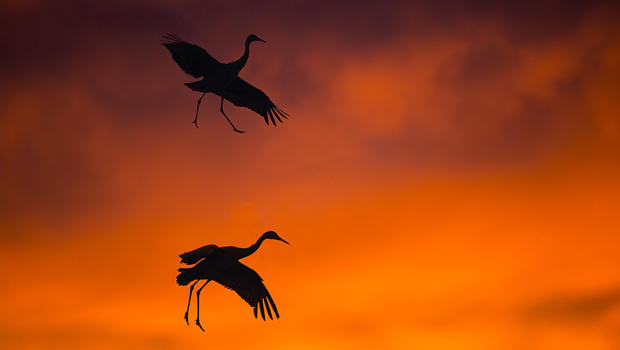Nature up close: Morning at Bosque del Apache
By "Sunday Morning" contributing videographer Judy Lehmberg.
My husband and I travel about nine months a year in a fifth-wheel trailer. Our goal is to be as far from civilization and as close to wild animals as possible. We know we are lucky and would like to share our experiences with others. I would like for you to imagine a morning in one of our favorite places several days ago.
We got up an hour before sunrise and went to a pond in Bosque del Apache National Wildlife Refuge in central New Mexico. It was still dark when we got there. The moon had already set so we could barely see the large, shallow pond. We knew there were sandhill cranes and snow geese on the pond, but we could hear them much better than we could see them.
Bird call of sandhill crane (Audubon)
As you listen, you hear mostly adult sandhill cranes along with a few whistles from their immature offspring, and the wingbeats of some early fliers. The sandhills have spent the night on the pond, presumably as protection from predators. They leave early to go out to feed on corn, tubers, and small animals. They almost never leave as one large group but usually in small family groups, in twos or threes.
Even when you've only been watching them a few minutes, you will quickly learn to recognize when they are ready to fly. One will start walking into the wind and watch its relatives. It is as if they are saying, "I think it's time to go get breakfast. Are you ready?" Sometimes they take off quickly, but occasionally one hesitates to be sure the rest of the family is coming along. "Are you ready to go? Are you sure? Come on, it's breakfast time and I'm hungry!"
Once they are airborne, they disappear from sight quickly, eager to find something to eat. As they fly, they call to each other. The conversations vary. "I'm flying. Are you coming?" "Wait for me! I didn't realize you were leaving so quickly!" "Hey Mom, I can't fly as fast as you can. Slow down!"
In the evening the cranes return to the pond for the night. They usually come back in in larger groups than when they left. Once they land the first order of business is a good, long drink of water and sometimes an argument with the neighbors. By the time it is dark they've usually settled down and are sleeping or just resting.
Travel Info:
Sandhills begin arriving at Bosque del Apache National Wildlife Refuge in late October and early November. They stay until sometime in February. Bosque del Apache employees and volunteers work hard to assure the cranes have productive wintering grounds. They plant corn, winter wheat and alfalfa, flood fields with water from the Rio Grande, and fight invasive, water-stealing plants such as salt cedar. There is lodging and restaurants in Socorro, a few miles north of Bosque del Apache.
Judy Lehmberg is a former college biology teacher who now shoots nature videos.
For more info:
- Judy Lehmberg (Official site)
- Judy Lehmberg's YouTube Channel
To watch extended "Sunday Morning" Nature videos click here!






